Robert Lansdale has shared a historic photo, from April 24, 1953, of the Colonel Samuel Smith homestead site in Long Branch, Ontario
A previous post is entitled:
Robert Lansdale has shared a 1929 photo from Long Branch, Ontario
Two earlier posts about Long Branch include:
Colonel Samuel Smith and his homestead: Speaking notes for October 2011 presentation
Long Branch Rifle Ranges, Long Branch Aerodrome, Long Branch Racetrack: What do they have in common?
An excerpt from the latter post reads:
Colonel Samuel Smith
After military service with the Queen’s Rangers in the American Revolutionary Wars, Colonel Samuel Smith was granted a large tract of land in 1793, which included all of what is now called Long Branch.
Originally a log cabin to which extensions and siding were added, the colonel’s house near Forty First Street and Lake Shore Blvd. West in Long Branch, was in continuous use for about 152 years, from 1797 until around 1949, before it was bulldozed in 1955.
Occasionally the date 1952 appears, especially online, and on captions on some archival photographs at Montgomery’s Inn, as the purported date of the latter demolition.
The available evidence, however, points definitively to 1955, as is evident from a Feb. 19, 1955 Toronto Star article, accessible at the Toronto Public Library website. From the latter article, it is clear that early in 1955, the Samuel Smith homestead house was still standing, awaiting its imminent demolition. Similarly, a Sept. 9, 1954 article in The Advertiser, about the same house, is entitled “Rare Historical Site Faces Demolition.”
Col. Samual Smith homestead, April 24, 1953
Robert Lansdale has shared this photo from April 24, 1953.
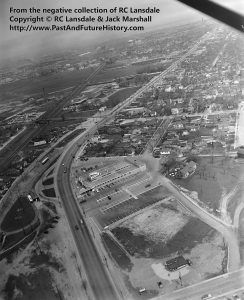
Lake Shore Blvd just east of the Etobicoke Creek on April 24, 1953. Colonel Samuel Smith’s homestead (demolished 1955) is at middle of photo slightly to the right; to the left of it is Dominion store. Copyright © RC Lansdale and Jack Marshall.

Detail from Lake Shore Blvd just east of the Etobicoke Creek on April 24, 1953. Colonel Samuel Smith’s homestead (demolished 1955) is at upper middle; on upper left is Dominion store. Copyright © RC Lansdale and Jack Marshall.
—————–
Robert Lansdale has noted:
This photo shows Lake Shore Blvd just east of the Etobicoke Creek on April 24, 1953. In particular, it shows Col. Samuel Smith’s homestead and Dominion, the former demolished 2 years later in 1955.
Copyright RC Lansdale and Jack Marshall.
—————–
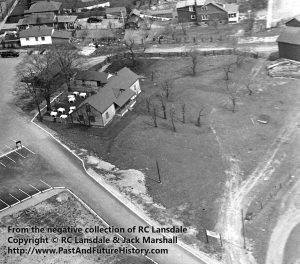
Detail from Lake Shore Blvd just east of the Etobicoke Creek on April 24, 1953. Colonel Samuel Smith’s homestead (demolished 1955). Copyright © RC Lansdale and Jack Marshall.
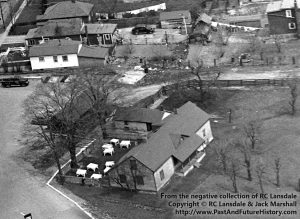
Detail from Lake Shore Blvd just east of the Etobicoke Creek on April 24, 1953. Colonel Samuel Smith’s homestead (demolished 1955). Copyright © RC Lansdale and Jack Marshall.

Detail from Lake Shore Blvd just east of the Etobicoke Creek on April 24, 1953, showing Dominion store. Copyright © RC Lansdale and Jack Marshall.
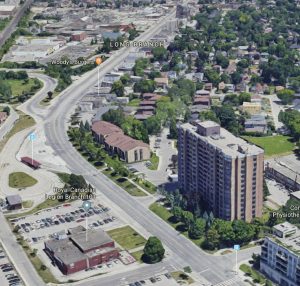
Aerial view from 2019: Lake Shore Blvd. West at Forty-First St. Copyright © RC Lansdale and Jack Marshall.
Previous posts
Click here for previous posts about Colonel Samuel Smith >
Click here for previous posts about the former Parkview School >
The school, located at 85 Forty First St. in Long Branch, is now named École élémentaire Micheline-Saint-Cyr.
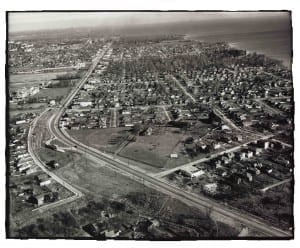
Aerial view from November 1949 looking east along Lake Shore Blvd West from near Long Branch Loop, Ontario Archives Acc 16215, ES1-814, Northway Gestalt Collection
The two photos – the November 1949 Ontario Archives aerial view and 1905 survey map – are from a post entitled:
Bernice Law recalls Col. Samuel Smith homestead site (Eastwood Farm) in the early 1930s
At the post I refer to a draft of a memoir that Bernice Law was working on before she passed away.
One of my ongoing projects involves editing a memoir that Bernice Law wrote during a project that she initiated with a letter to the Toronto Star over twenty years ago. An excerpt from the above-noted post reads:
We owe thanks to Bernice Law for organizing this great local history project.
First-person accounts of life along the Lakeshore in earlier times are of tremendous value. They bring to life what otherwise would remain unknown for many of us. Often when I read such memoirs, images that I like to call “word pictures” come to mind. I much enjoy imagining what is being described in the passages that I read.
Many of the memoirs or life stories that Bernice Law has brought together are available in a local history collection at the Long Branch Library.
The following text is from a draft of Bernice Law’s own memoir, which was not included in the above-noted collection. An aerial photo and several maps are included below to provide context for the text.
Eastwood Farm
As you will see on the subdivision map [two such maps can be viewed below], the remnants of the original farm remained and were surrounded by building lots. On the north side of James Street, where several apartments now stand, not far back from the road, stood a large weathered but unpainted barn. The barn on James Street was for storage of forage and hay. It was fenced in with a wire fence and occasionally the horses were there as we walked by on our “back” way to school. But the largest part of the old farm fronted on Lakeshore Road [now Lake Shore Blvd. West] consisting of two large fields divided by the farm lane leading to the houses and farm buildings. The Eastwoods still kept about four large farm horses, beautiful animals that consistently won prizes when entered into competitions at the Royal Agricultural Winter Fair. In good weather, they regularly pastured in these fields.
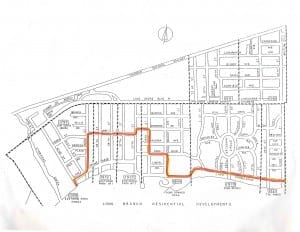
Long Branch subdivisions map.The coloured line shows the route of a Jane’s Walk in Long Branch in May 2013.
In the westernmost field several hundred yards back from the highway was a small orchard, what was left of a much larger one, I suspect, from times past. When I was a young child, perhaps six or seven years old [in the early 1930s], I was occasionally dispatched to the farm with a six-quart fruit basket and a dime to pick windfalls from under the apple trees.
I was given strict instructions on opening and closing the farm gates and knocking at the house door to ask permission to go into the orchard. In those days, the house was still occupied by two very elderly members of the Eastwood family, a brother and a sister who had never married. Eventually the old lady contracted cancer in her jaw and had a large open wound on the side of her face which must have given her great discomfort but she still looked after her brother and I remember her fondly as a sweet, gentle person. When I first went she came with me to the orchard to instruct me on the various varieties – Snows and Russetts – and on selecting only the most wholesome windfalls.
It is hard now to visualize all the farm buildings surrounding the yard but it is my impression that there were at least two residential buildings on the south west and, on the east, buildings which housed the animals, carriages and equipment.
Eastwood Hotel
Stories about the Eastwood Farm bring to mind the Eastwood Hotel; a previous post is entitled:
Tales of drinking and brawling at Eastwood Hotel remind me of Norse mythology
An excerpt (with accompanying photos taken with a vintage Nikon 35mm camera – which I had originally acquired when it was an all-new, state of the art product [1]) reads:
A March 27, 2008 Etobicoke Guardian article, entitled “Bittersweet moment as historic Etobicoke hotel is demolished,” highlights the hotel’s history.
Air thick with smoke
I will not try to recount details, aside from the air being thick with smoke, that I remember from interviews or conversations I’ve recorded regarding the Eastwood Hotel. Instead, I’ll wait until I’ve transcribed the recordings before I post the details.
What I can share right now, however, are a couple of my own stories. I will also share thoughts about the Eastwood Hotel and Norse mythology.
Reputation
The first story concerns how far a bad reputation can travel. In this case it travelled from Kipling Ave. just east of the eastern border of Long Branch to just west of Fortieth St., almost all the way to the western border of the Long Branch neighbourhood. It goes back to 1997.
We bought a house in 1997 on Villa Road, a 10-minute walk from the hotel. Around that time, we got word that living that close to the Eastwood Hotel was possibly not the best idea. The source of the helpful commentary was an institution of secondary education, located at Kipling Ave. and Birmingham. [That is, teachers at a local high school would talk about the reputation attached to the hotel, and some of those tales came our way when we were in the process of buying a house.]
Fortunately, things turned out well for us, despite the proximity to the Eastwood Hotel. Indeed, over time it was established that the proximity to the hotel had no bearing on the value of our house, or on our well-being as residents of Long Branch.
Driving under the influence
The second story concerns an occasion, perhaps around the late 1990s, when I was walking home one evening on the south side of Lake Shore Blvd. West just west of Thirty Seventh St.
As I was walking, I noticed an older-model car parked in front of the Eastwood Hotel. I also noticed a bar patron stepping forward from the hotel. Unsteady on his feet, being from what I could gather under the influence, the person in question opened the door of the parked car that I had just noticed and drove off. I noted the license plate and called 911 on our landline phone when I got home.
Norse mythology refers to Valhalla, where warriors who have died in battle relive their days of glory
And now for my essay, regarding what comes to mind, when I think about stories that I’ve heard, about days and nights of brawling and drinking at the Eastwood Hotel.
The brawling and drinking occurred in a setting so thick with cigarette smoke, that you could take out a knife, and cut the smoke with it.
That’s what I heard recently, from Garry Burke who paid a brief visit to the hotel on an errand, many years ago when he was an adolescent. The smoke was so heavy you could cut it with a knife. Garry Burke said, and I paraphrase, “Talk about second-hand smoke!”
After we sold our house in Long Branch in July 2018 and before we bought a house in Stratford, we stayed at short-term rentals across Ontario and hotels across Europe, as I’ve noted at a previous post.
On the way back to Canada in September 2018, I picked up a book about Norse legends.
When I think of the brawling and drinking at the Eastwood Hotel of long ago, I think of the story of Valhalla, which is prominently featured in Norse mythology.
Valhalla Inn
When I think of Valhalla, I also think about the Valhalla Inn, which used to be in place until 2009 where a condo now stands, along the 427 as you’re travelling north toward Burnamthorpe.
Often when I’ve driven by that location, I’ve thought about a remark, by a lawyer friend named Michael Niven who lives in Calgary.
He and I were both members of a board of directors of a national nonprofit organization that we both had been involved in founding at a conference in Banff, Alberta, in 1991. Some years later, we had an annual meeting for the organization, at our family’s home on Villa Road. On that occasion, Michael rented a room at the Valhalla Inn.
On the way to the airport after the board meeting, or on some other occasion during his visit to Toronto, I asked Michael Niven how his stay at the Valhalla Inn had turned out. “Oh,” he said, and I paraphrase, “it’s a good place to stay. It’s a place that’s in keeping with my station in life.” (Michael has a sense of humour.)
I liked the expression – “my station in life.” From time to time I’ve been reading extensively about the history of the British empire, and Michaels’ remark reminded me of how, in the mythology related to the British empire, each person was assigned to a particular station in life, and everybody (from highest to lowest) was expected to affirm contentment with being an integral player in the vast expanses, and vast populations, of the empire. [2]

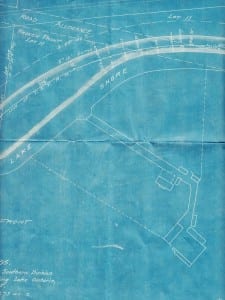

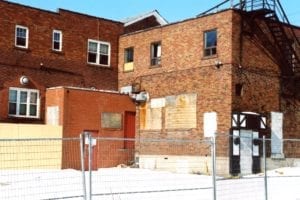
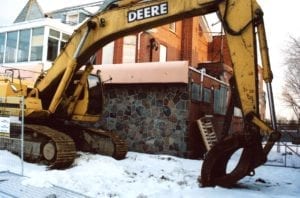
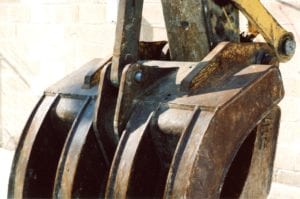
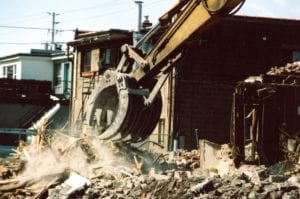
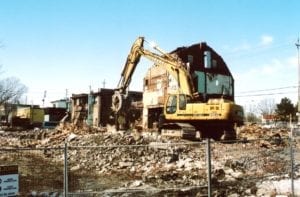
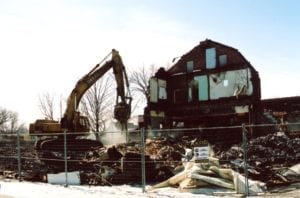
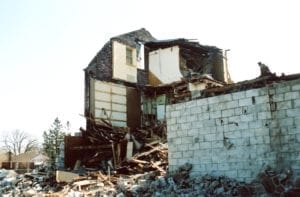
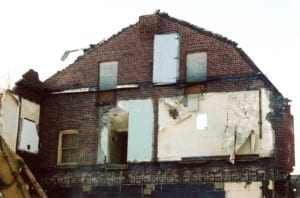

Note 1
35mm photography differs from its digital counterpart
The Nikon 35mm photos of the Eastwood Hotel teardown featured at this post have a distinctive quality; they underline that 35mm photography differs in significant ways from its digital counterpart.
Regarding the history of photography in Canada a good reference is The Other Side of 150: Untold Stories and Critical Approaches to History and Literature in Canada (2021).
A blurb reads:
On the Other Side(s) of 150 explores the different literary, historical and cultural legacies of Canada’s sesquicentennial celebrations. It asks vital questions about the ways that histories and stories have been suppressed and invites consideration about what happens once a commemorative moment has passed.
Like a Cubist painting, this modality offers a critical strategy by which also to approach the volume as dismantling, reassembling, and re-enacting existing commemorative tropes; as offering multiple, conditional, and contingent viewpoints that unfold over time; and as generating a broader (although far from being comprehensive) range of counter-memorial performances.
The chapters in this volume are thus provisional, interconnected, and adaptive: they offer critical assemblages by which to approach commemorative narratives or showcase lacunae therein; by which to return to and intervene in ongoing readings of the past from the present moment; and by which not necessarily to resolve, but rather to understand the troubled and troubling narratives of the present moment. Contributors propose that these preoccupations are not a means of turning away from present concerns, but rather a means of grappling with how the past informs or is shaped to inform them; and how such concerns are defined by immediate social contexts and networks.
I was interested to read a chapter in the above-noted book, related to the history of photography, which speaks of picture taking in the context of Mennonite history.
Expression of human agency at land use meetings
A related topic concerns the fact that 16mm and 35mm filmmaking differs in significant ways from digital filmmaking. Building upon experience in reviewing 16mm short films in the 1970s, I’ve recently had a crack at film reviews of Zoom land use meetings:
Cinematic-quality land use hearings were held on Oct. 25, 2021 in the City of Stratford, and on Jan. 10, 2022 in the Town of Niagara on the Lake; here’s a quick film review
An excerpt reads:
My review of online land use meetings in Stratford and Niagara on the Lake
My review is based on what I recollect of these engaging, compelling online videos, which are focused on topics where much is at stake.
The most recent video depicts a meeting held on Jan. 10, 2022. I learned of this event from Mike James, who lives in Niagara on the Lake. For many years Mike and I led Jane’s Walks in South Etobicoke when I lived in Long Branch and Mike lived in Brampton. We share a keen history in local history.
The tone of the Niagara on the Lake meeting regarding the Parliament Oak redevelopment proposal was uniformly positive. The Stratford meeting regarding a redevelopment proposal, for a stretch of land between Queen Street and Trow Avenue, on the north side of Ontario Street, had a less positive feeling attached to it.
The residents who spoke in opposition to the Parliament Oak proposal as it currently stands uniformly adopted a tone of cordiality, even when they spoke strongly in opposition to the proposal.
The residents who spoke in opposition to the Queen Street proposal in some cases adopted a tone of cordiality but in other cases expressed strong contempt. In my capacity as a film reviewer, I can say that beyond a doubt, a tone of cordiality, when speaking strongly against a proposal, is going to have stronger traction; such a tone makes for a stronger demonstration of human agency.
Photographic Historical Society of Canada
I’ve written previously about the Photographic Historical Society of Canada.
Bob Lansdale, father of Robert Lansdale and past editor of the Photographic Historical Society of Canada newsletter, is featured in previous posts including one entitled:
Comment from Bob Lansdale regarding proposal to remove sand beach between Etobicoke Creek and Applewood Creek
An excerpt reads:
In earlier blog posts – which have been viewed and commented upon by many site visitors – I’ve shared photos from Robert Lansdale from the 1920s to the 1940s when a cottage community existed at the mouth of Etobicoke Creek.
I very much appreciate the fact that the Durance family has shared their historic family photos with me, and that I have the opportunity to share them with visitors to my website. The photos are evocative and enjoyable to view.
In a recent blog post I’ve shared information about the proposal to remove the sand beach between Etobicoke Creek and Applewood Creek on the Long Branch side of Marie Curtis Park.
I’ve also shared comments from David Switzer regarding the beach proposal.
Below are comments about the proposal from Bob Lansdale who also recently shared a photo of a 1917 photo of the “Y” Squadron at the First World War flying school at the Long Branch Aerodrome.
Bob Lansdale writes:
I can’t see in the plans where they would “cobble” the beaches. It seems unnecessary from a history point of view. In my youth the best sand beaches were in the Rifle Ranges area with less sand (but good beaches) over to the Etobicoke Creek.
Adding the stone islands may be to protect the beaches from erosion but doing the same for the beaches would be insane and take away a feature that the public has enjoyed for decades.
The combination of these plans makes me wonder if there is something else in the works which we aren’t being told of. Such as raising the level of the lake to assist the St. Lawrence Seaway project. Raising the level was responsible for the destruction of all the housing along Lake Promenade in the “flats area”. The raised water level and the fall storms brought utter destruction as beaches were eroded away and then the houses destroyed.
Protective islands – maybe, the cobbled beaches – no!
Bob Lansdale
As I’ve noted at this website, the plan to remove most of the sand beach at Marie Curtis Park was abandoned as work proceeded on the Lakeview waterfront project.
Note 2
I’ve revised the note I originally posted here.
I had originally referred, by way of Note 2, to a Jan. 22, 2022 Globe and Mail article; further reading has convinced me that a better article, regarding the topic of truth-seeking as we look back on the British empire, is this one:
A Jan. 27, 2022 article at the HealthyDebate website by Concerned researchers and experts from CoVaRR-Net is entitled: “Let evidence be our guide: Misinformation most insidious when it comes from health-care professionals.”
The article warrants close study; an excerpt reads:
The harm caused by such insidious distortions of science reverberate beyond the traditional anti-vaccine echo chambers. They cause harm even among many conscientious Canadians who do not typically fall prey to misinformation. The Saturday morning ritual of reading the Globe and Mail for a Vancouver family was turned on its head when the Doidge article was read. The family is vaccinated and waiting for third-dose appointments for two teenage sons. However, reading this piece fraught with misrepresented evidence opened the way for doubt and anxiety in the mind and heart of one parent. The other parent, a professor of immunology and microbiology, was able to address questions and offer reassuring, accurate information. What of the many Canadians who have experienced similar anxieties, doubts, and fears because of the misinformation sprinkled throughout this article and have little to no access to accurate sources of information?
I have devoted a separate post to this topic:
At the HealthyDebate website, I’ve found a powerful rebuttal to a lengthy Jan. 22, 2022 Globe and Mail article about COVID-19